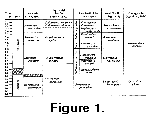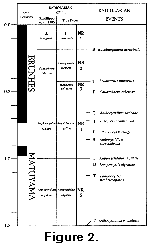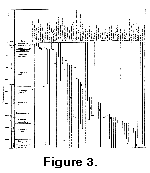ZONAL
DEFINITIONS
This section contains a
description of the limits of 32 presently recognized low-latitude zones and 11
presently recognized middle-latitude zones.
Low
Latitude Zonation
 The
low-latitude zonation presented herein for the Quaternary is that of Nigrini
(1971). The rest of the low-latitude zonation is primarily that of Riedel and
Sanfilippo (1978a), with some subsequent modifications by Sanfilippo et al.
(1985) and Sanfilippo and Riedel in Saunders et al. (1985). The oldest zone
recognized is the Bekoma
campechensis Zone in the Late Paleocene (Nishimura, 1987). The reader
is, however, directed to a more recent review and modification of the
low-latitude zonation in Sanfilippo and Nigrini (1998; see Addendum).
The
low-latitude zonation presented herein for the Quaternary is that of Nigrini
(1971). The rest of the low-latitude zonation is primarily that of Riedel and
Sanfilippo (1978a), with some subsequent modifications by Sanfilippo et al.
(1985) and Sanfilippo and Riedel in Saunders et al. (1985). The oldest zone
recognized is the Bekoma
campechensis Zone in the Late Paleocene (Nishimura, 1987). The reader
is, however, directed to a more recent review and modification of the
low-latitude zonation in Sanfilippo and Nigrini (1998; see Addendum).
 Other
zonal schemes have been presented for parts of the Cenozoic or for specific
regions, but are not widely applicable. Goll (1980) described a zonal scheme for
the Pliocene-Pleistocene based on DSDP Leg 54 material from the Eastern Pacific
(Fig. 1). Johnson et al. (1989)
proposed a zonal scheme for the Pliocene-Pleistocene of the tropical Indian
Ocean (Fig. 2). Moore (1971)
suggested that the Dorcadospyris
ateuchus Zone be divided into the Dorcadospyris
papilio and Theocyrtis
annosa Zones, based on the first appearance of Dorcadospyris
papilio. Additional zonal modifications can be found throughout the
DSDP/ODP (Deep Sea Drilling Project/Ocean Drilling Program) volumes.
Other
zonal schemes have been presented for parts of the Cenozoic or for specific
regions, but are not widely applicable. Goll (1980) described a zonal scheme for
the Pliocene-Pleistocene based on DSDP Leg 54 material from the Eastern Pacific
(Fig. 1). Johnson et al. (1989)
proposed a zonal scheme for the Pliocene-Pleistocene of the tropical Indian
Ocean (Fig. 2). Moore (1971)
suggested that the Dorcadospyris
ateuchus Zone be divided into the Dorcadospyris
papilio and Theocyrtis
annosa Zones, based on the first appearance of Dorcadospyris
papilio. Additional zonal modifications can be found throughout the
DSDP/ODP (Deep Sea Drilling Project/Ocean Drilling Program) volumes.
Middle
Latitude Zonation
The middle-latitude
zonation is that of Hays (1970) and Foreman (1975). This zonal scheme is
satisfactory from the Holocene to the upper Pliocene (Lamprocyrtis
heteroporos Zone). However, we have found that it is difficult to
recognize the Sphaeropyle
langii Zone and feel that this part of the zonation needs to be
revised. Below the Sphaeropyle
langii Zone researchers have tried, with varying success, to apply
the tropical zonation of Riedel and Sanfilippo (1978a), but the fauna is
sufficiently different to make this both difficult and ultimately
unsatisfactory. However, because we do not presently have any better scheme, we
have chosen to include the commonly used zonation but with the original (1978a)
zonal definitions.
 Reynolds
(1980), working on Miocene to Holocene material from DSDP Leg 57 in the North
Pacific, attempted to integrate the tropical zonation of Riedel and Sanfilippo
(1978a) with several new zones (Fig. 3),
but his zonation has not been applied by other workers. The reader should also
note the more recent papers by Morley and Nigrini (1995; see Addendum) and
Shilov (1995; see Addendum).
Reynolds
(1980), working on Miocene to Holocene material from DSDP Leg 57 in the North
Pacific, attempted to integrate the tropical zonation of Riedel and Sanfilippo
(1978a) with several new zones (Fig. 3),
but his zonation has not been applied by other workers. The reader should also
note the more recent papers by Morley and Nigrini (1995; see Addendum) and
Shilov (1995; see Addendum).
Radiolarian
Events
Within each zone there is
a list of radiolarian "events," which are based on morphotypic first
and last appearances or evolutionary transitions. A dash in front of the event
(or group of events) separates it in time from the event(s) above and below.
Events separated by semicolons are approximately synchronous. The first and last
appearance of a taxon is indicated as "Bm" (earliest morphotypic
appearance) and "Tm" (latest morphotypic appearance), and an
evolutionary transition (Ev) with an arrow. "Morphotypic" and
"evolutionary" limits, as applied in the zonal definitions, are
explained in Riedel and Sanfilippo (1971, p. 1530).
In referring to the list
of radiolarian events, the worker should realize that the list is based
primarily on Pacific Ocean material. It should NOT be assumed that these events
are synchronous from one latitude to another or even within a given latitudinal
belt (Johnson and Nigrini, 1985).

 The
low-latitude zonation presented herein for the Quaternary is that of Nigrini
(1971). The rest of the low-latitude zonation is primarily that of Riedel and
Sanfilippo (1978a), with some subsequent modifications by Sanfilippo et al.
(1985) and Sanfilippo and Riedel in Saunders et al. (1985). The oldest zone
recognized is the Bekoma
campechensis Zone in the Late Paleocene (Nishimura, 1987). The reader
is, however, directed to a more recent review and modification of the
low-latitude zonation in Sanfilippo and Nigrini (1998; see Addendum).
The
low-latitude zonation presented herein for the Quaternary is that of Nigrini
(1971). The rest of the low-latitude zonation is primarily that of Riedel and
Sanfilippo (1978a), with some subsequent modifications by Sanfilippo et al.
(1985) and Sanfilippo and Riedel in Saunders et al. (1985). The oldest zone
recognized is the Bekoma
campechensis Zone in the Late Paleocene (Nishimura, 1987). The reader
is, however, directed to a more recent review and modification of the
low-latitude zonation in Sanfilippo and Nigrini (1998; see Addendum). Other
zonal schemes have been presented for parts of the Cenozoic or for specific
regions, but are not widely applicable. Goll (1980) described a zonal scheme for
the Pliocene-Pleistocene based on DSDP Leg 54 material from the Eastern Pacific
(Fig. 1). Johnson et al. (1989)
proposed a zonal scheme for the Pliocene-Pleistocene of the tropical Indian
Ocean (Fig. 2). Moore (1971)
suggested that the Dorcadospyris
ateuchus Zone be divided into the Dorcadospyris
papilio and Theocyrtis
annosa Zones, based on the first appearance of Dorcadospyris
papilio. Additional zonal modifications can be found throughout the
DSDP/ODP (Deep Sea Drilling Project/Ocean Drilling Program) volumes.
Other
zonal schemes have been presented for parts of the Cenozoic or for specific
regions, but are not widely applicable. Goll (1980) described a zonal scheme for
the Pliocene-Pleistocene based on DSDP Leg 54 material from the Eastern Pacific
(Fig. 1). Johnson et al. (1989)
proposed a zonal scheme for the Pliocene-Pleistocene of the tropical Indian
Ocean (Fig. 2). Moore (1971)
suggested that the Dorcadospyris
ateuchus Zone be divided into the Dorcadospyris
papilio and Theocyrtis
annosa Zones, based on the first appearance of Dorcadospyris
papilio. Additional zonal modifications can be found throughout the
DSDP/ODP (Deep Sea Drilling Project/Ocean Drilling Program) volumes.
 Reynolds
(1980), working on Miocene to Holocene material from DSDP Leg 57 in the North
Pacific, attempted to integrate the tropical zonation of Riedel and Sanfilippo
(1978a) with several new zones (Fig. 3),
but his zonation has not been applied by other workers. The reader should also
note the more recent papers by Morley and Nigrini (1995; see Addendum) and
Shilov (1995; see Addendum).
Reynolds
(1980), working on Miocene to Holocene material from DSDP Leg 57 in the North
Pacific, attempted to integrate the tropical zonation of Riedel and Sanfilippo
(1978a) with several new zones (Fig. 3),
but his zonation has not been applied by other workers. The reader should also
note the more recent papers by Morley and Nigrini (1995; see Addendum) and
Shilov (1995; see Addendum).